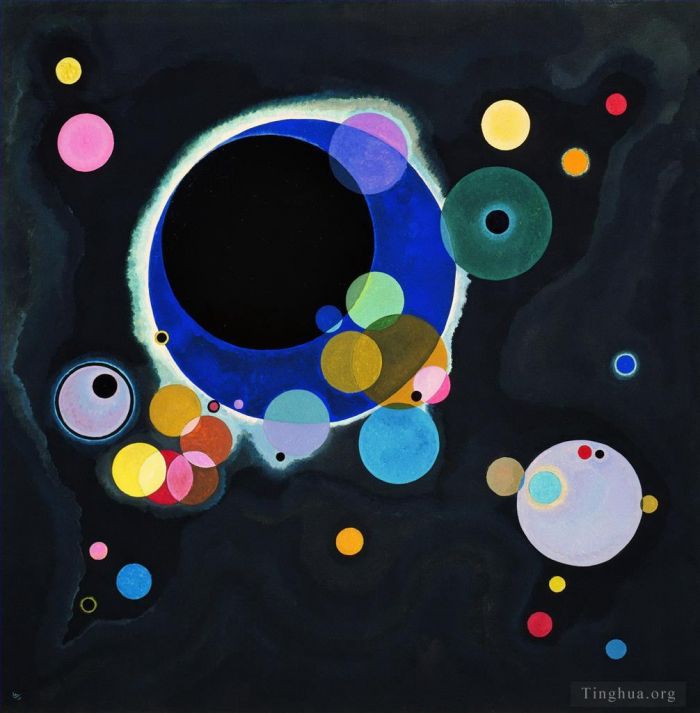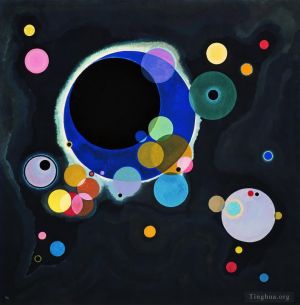Several Circles Einige Kreise
Wassily Kandinsky
- Price: Price on Request
- Art Type: Various Paintings
- Size:
- English Comments: 0
- International Comments: 0
- Creating Date:
- Introduction and Works of Wassily Kandinsky >>
Work Overview
- Several Circles ( Einige Kreise )
January–February 1926
Oil on canvas
55 1/4 x 55 3/8 inches (140.3 x 140.7 cm)
When Kandinsky returned to his native Moscow after the outbreak of World War I, his expressive abstract style underwent changes that reflected the utopian artistic experiments of the Russian avant-garde. The emphasis on geometric forms, promoted by artists such as Kazimir Malevich, Aleksandr Rodchenko, and Liubov Popova in an effort to establish a universal aesthetic language, inspired Kandinsky to expand his own pictorial vocabulary. Although he adopted some aspects of the geometrizing trends of Suprematism and Constructivism—such as overlapping flat planes and clearly delineated shapes—his belief in the expressive content of abstract forms alienated him from the majority of his Russian colleagues, who championed more rational, systematizing principles. This conflict led him to return to Germany in 1921. In the Black Square, executed two years later, epitomizes Kandinsky’s synthesis of Russian avant-garde art and his own lyrical abstraction: the white trapezoid recalls Malevich’s Suprematist paintings, but the dynamic compositional elements, resembling clouds, mountains, sun, and a rainbow, still refer to the landscape.
In 1922 Kandinsky joined the faculty of the Weimar Bauhaus, where he discovered a more sympathetic environment in which to pursue his art. Originally premised on a Germanic, expressionistic approach to artmaking, the Bauhaus aesthetic came to reflect Constructivist concerns and styles, which by the mid-1920s had become international in scope. While there, Kandinsky furthered his investigations into the correspondence between colors and forms and their psychological and spiritual effects. In Composition 8, the colorful, interactive geometric forms create a pulsating surface that is alternately dynamic and calm, aggressive and quiet. The importance of circles in this painting prefigures the dominant role they would play in many subsequent works, culminating in his cosmic and harmonious image Several Circles. “The circle,” claimed Kandinsky, “is the synthesis of the greatest oppositions. It combines the concentric and the eccentric in a single form and in equilibrium. Of the three primary forms, it points most clearly to the fourth dimension.”
- Copyright Statement:
All the reproduction of any forms about this work unauthorized by Singing Palette including images, texts and so on will be deemed to be violating the Copyright Laws.
To cite this webpage, please link back here.
- >> English Comments
- >> Chinese Comments
- >> French Comments
- >> German Comments
- >>Report
- Autumn in Bavaria
- St George and the dragon
- In Gray Im Grau
- White sound
- Grungasse in Murnau
- Study for sluice
- Park of St Cloud with horseman
- White Cross WeiBes Kreuz
- Old town II
- Houses at Murnau
- White oval
- Autumn in Murnau
- Sketch for Composition II Skizze fur Komposition II
- Beach Baskets In Holland
- Two riders and reclining figure
- Improvisation 21A
- Rapallo Grauer day
- Arabs I Cemetery
- Twilight
- Improvisation 11
- Improvisation 31
- Unknown
- Picture with archer
- Improvisation 26
- Angel of the Last Judgment
- Improvisation 30
- Forest edge
- In Grey
- Improvisation 7
- Improvisation xiv 1910
- Mountain landscape with church
- Blue rider
- Crinolines
- Blue mountain
- Moscow Zubovskaya Square Study
- Rapallo boats
- Composition IV
- Composition VII
- All Saints day II
- Improvisation 209
- Study for autumn
- Interior My dining room
- Winter Landscape
- Glass Painting with the Sun Small Pleasures
- Murnau view with railway and castle
- Red Spot II Roter Fleck II
- Munich Schwabing with the church of St Ursula
- Complex Simple
- Black Lines Schwarze Striche
- Murnau with rainbow
- Cemetery and vicarage in Kochel
- Landscape with factory chimney
- Painting with red spot
- Sketch for Composition VII
- White Line 2
- Moscow I Moskau I
- The Blue Mountain Der blaue Berg
- Contrasting sounds
- In Blue
- Ancient Russia
- Murnau with a church
- Small dream in red
- Rotterdam sun
- Improvisation 19
- Improvisation Dreamy
- Improvisation 28
- Picture with a black arch
- Black spot 1912
- Painting with White Border
- Composition V
- Romantic
- Bedroom in Aintmillerstrasse
- All Saints day I
- Improvisation 12
- Unknown3
- Flood improvisation
- Lady in Moscow
- Fugue
- Squares with Concentric Circles
- Group in Crinolines
- Unknown2
- Picture with a Circle Bild mit Kreis
- Small Pleasures
- Murnau Garden
- Santa Marguerite
- With the Black Arch
- Painting on light ground
- Park of St Cloud
- Red Wall destiny
- Gabriele Munter painting
- Gabriele Munter
- Painting with green center
- Composition VI
- Lyrically
- Grouping
- Black Frame
- Last watercolour
- To the Unknown Voice
- A Motley Life Das Bunte Leben
- Development
- Decisive Pink
- Impression V
- Dominant curve
- Small worlds III
- Sky Blue Bleu de ciel
- Mild process
- Untitled
- Capricious
- Impression III
- Around the circle
- Fragile
- Dark freshness
- The cow
- Picture XVI
- White figure
- The singer
- Study for Circles on Black
- Landscape with red spots
- Conglomerat
- The elephant
- Tempered Elan
- White line
- Intime message
- Composition IX
- Soft roughness
- Arab Town
- Transverse Line
- Movement I
- The last judgment
- Accent on rose
- Small worlds IV
- Fixed points
- A floating figure
- Composition X
- A mountain
- Thirty Trente
- Colourful Ensemble
- Moonlight night
- On White II
- On the points
- Horses
- Black and Violet
- Various Parts Parties diverses
- Black Relationship
- Compensation rose
- Improvisation 3
- Green emptyness
- Green composition
- At rest
- Untitled 1941
- Succession
- Upward
- Boat Trip
- Small worlds
- Downwards
- Storeys
- Grey oval
- Yellow Red Blue
- Orange
- Composition VIII
- Improvisation 6
- Unknown 4
- Farewell
- Draft for mural in the unjuried art show wall b 1922
- Volga song
- Russian beauty in a landscape
- Orange Violet
- Composition
- First abstract watercolor
- Small worlds II
- Couple riding
- Black Grid Schwarzer Raster
- Several Circles Einige Kreise
- Reciprocal Accords
- Brown with supplement
- Black Red
- Blue Segment Blaues Segment
- Picture With A White Border
- Black strokes I
- Gentle accent
- Unknown 5
- Small Worlds VII
- Red Oval
- Merry Structure
- Moscow Smolensky boulevard Study









 Singing Palette
Singing Palette